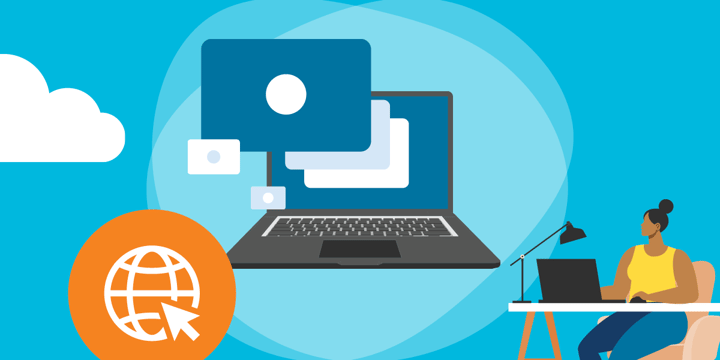Do you feel like you're using too many apps? Do you find yourself jumping between several different pieces of software to complete a given task? Do you feel like you're wasting time and energy by entering information into multiple places?

If any of this sounds familiar, you might benefit from some all-in-one software packages. Also called enterprise resource planning (ERP) software, this type of software solution puts a number of related tools you use on a daily basis under one interface. Think of it as a software equivalent of a multi-tool.
ERP software varies greatly and can cover a wide range of needs. For example, a marketing and outreach ERP may include email marketing capabilities, a contact database, and website builder tools. A financial planning ERP like QuickBooks might help you create a budget, track your transactions, and more. A human resources ERP might cover payroll, time-off tracking, and benefits management. And so on.
Types of ERP Solutions
ERP software is a broad term that encompasses numerous systems. Below, we explain the main categories for these systems.
By Tier
This is the traditional way that ERP software gets categorized. It is based on the size of the company that is using it, as a larger company has more advanced needs. There are four tiers:
- Tier I: For large, global companies
- Tier II: For mid-sized, global companies
- Tier III: For mid-sized companies in one country
- Tier IV: For small companies in one country
By Deployment
Deployment refers to how you set up and manage the ERP. There are three classifications for this:
- Cloud: Cloud-based software has a tech team that manages the infrastructure for you. All you have to do is log in through your browser. Examples include Springly and HubSpot.
- Onsite: This type of solution is for a large company that needs a complex solution and has in-house tech professionals to run it.
- Hybrid: Hybrid software is a custom solution that blends some features of both cloud and onsite systems.
By Industry
ERP software can be specialized to help with one specific industry. These are some common specializations:
- Accounting: This type of solution helps you create a budget, track your transactions, and more. QuickBooks is a popular accounting ERP.
- Marketing: Marketing includes building websites, creating social media posts, and sending newsletters, among other forms of communication. HubSpot can do all of this and more.
- Human resources: Maybe you need a way to pay your employees, track their time off, and manage their benefits. Gusto or another HR platform can do this.
This guide looks at one industry in particular — nonprofit organizations. Nonprofits need accounting and marketing help like businesses, but they also need to fundraise, plan events, and store donor data. Nonprofit ERP solutions can help with some or all of these duties. And by helping with these duties, ERPs offer nonprofits the following advantages.
5 Reasons to Invest in All-in-One Software
Enter Data Only Once
If you use different tools for your various technology needs, you're probably entering the same data into each one separately. With an all-in-one software package, you can keep your contacts' details in one centralized location so that you don't have to reenter them. This streamlines your campaigns, saving you time on day-to-day operations.
Reduce Your Software Costs
The costs associated with using many different apps can quickly add up. When you use multiple apps with overlapping functionality, you can end up spending more than you need to. You can usually get an ERP solution for less than the total of all these individual tools. A single subscription also ensures spending transparency because you make one payment to one provider.
Improve Your Data Security
ERP software comes with a few security benefits as well. First, when you have only one system storing personal data, hackers have fewer ways to access it. In addition, ERPs tend to have strong security measures in place since they are designed to store a lot of sensitive personal data. Take HubSpot, for example. HubSpot prioritizes security and privacy with password-protected pages, two-factor authentication, and other features.
And since an ERP keeps sensitive data in one place, you're able to keep tighter controls over who can access it. You can assign access privileges to each person based on what they need to do their job. This ensures that only certain individuals have access to sensitive information.
Use a Single Password
How often do you reset a password because you have too many to remember? With all-in-one software, you just have to keep track of a single password to access all the tools you use on a daily basis. And If a staff member's account does get compromised, you only have one account to shut down — you don't have to chase down multiple accounts across multiple systems.
Simplify Training
When you onboard a new employee or volunteer, you no longer have to spend an hour (or more) explaining how to use each tool. Now, you just have to go over one system. This saves everyone time, letting you get back to your job faster and helping them get familiar with the tool faster.
Discover the Power of All-in-One Tools
For many organizations, ERP software is a more cost-effective and time-efficient alternative to having multiple tools to meet various needs. Get inspired and start exploring all-in-one tools.
About the Author
Katie Gray is the head of content at Springly, which produces ERP software for nonprofits. TechSoup works with Springly to provide its member management software to eligible nonprofits at discounted rates.
Additional Resources
- Get some pointers on Making the Right Move into New Nonprofit Tech.
- Learn about 9 Ways to Avoid Overspending on Your Nonprofit's Technology.
- Enroll in TechSoup Courses' All Access Pass to Successful Tech Planning.
Top photo: Shutterstock








